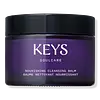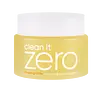What's inside
What's inside
 Key Ingredients
Key Ingredients

 Benefits
Benefits

 Concerns
Concerns

 Ingredients Side-by-side
Ingredients Side-by-side

Cetyl Ethylhexanoate
EmollientHelianthus Annuus Seed Oil
EmollientMacadamia Ternifolia Seed Oil
EmollientPEG-20 Glyceryl Triisostearate
EmollientSynthetic Wax
AbrasivePEG-10 Isostearate
EmulsifyingCamellia Oleifera Seed Oil
Skin ConditioningButyrospermum Parkii Butter
Skin ConditioningHoney Extract
HumectantCharcoal Powder
AbrasiveWater
Skin ConditioningDipropylene Glycol
HumectantTocopherol
AntioxidantParfum
MaskingEthylhexylglycerin
Skin ConditioningCetyl Ethylhexanoate, Helianthus Annuus Seed Oil, Macadamia Ternifolia Seed Oil, PEG-20 Glyceryl Triisostearate, Synthetic Wax, PEG-10 Isostearate, Camellia Oleifera Seed Oil, Butyrospermum Parkii Butter, Honey Extract, Charcoal Powder, Water, Dipropylene Glycol, Tocopherol, Parfum, Ethylhexylglycerin
Ethylhexyl Stearate
EmollientPEG-20 Glyceryl Triisostearate
EmollientPEG-10 Isostearate
EmulsifyingSynthetic Wax
AbrasiveCarthamus Tinctorius Seed Oil
MaskingPolyglyceryl-2 Triisostearate
EmulsifyingButylene Glycol
HumectantWater
Skin ConditioningParfum
MaskingGlyceryl Caprylate
EmollientCaprylyl Glycol
EmollientPanax Ginseng Root Extract
EmollientPanax Ginseng Berry Extract
Skin ConditioningButyrospermum Parkii Butter
Skin ConditioningSimmondsia Chinensis Seed Oil
EmollientOnsen-Sui
1,2-Hexanediol
Skin ConditioningChenopodium Quinoa Seed Extract
Skin ConditioningPanax Ginseng Root Water
MaskingTheobroma Cacao Extract
Skin ConditioningDextrin
AbsorbentGlycine Max Polypeptide
Skin ConditioningLactobacillus Ferment
Skin ConditioningAvena Sativa Meal Extract
SoothingPanax Ginseng Seed Oil
EmollientLactobacillus
Skin ConditioningHydrolyzed Ginseng Saponins
Skin ConditioningEthylhexyl Stearate, PEG-20 Glyceryl Triisostearate, PEG-10 Isostearate, Synthetic Wax, Carthamus Tinctorius Seed Oil, Polyglyceryl-2 Triisostearate, Butylene Glycol, Water, Parfum, Glyceryl Caprylate, Caprylyl Glycol, Panax Ginseng Root Extract, Panax Ginseng Berry Extract, Butyrospermum Parkii Butter, Simmondsia Chinensis Seed Oil, Onsen-Sui, 1,2-Hexanediol, Chenopodium Quinoa Seed Extract, Panax Ginseng Root Water, Theobroma Cacao Extract, Dextrin, Glycine Max Polypeptide, Lactobacillus Ferment, Avena Sativa Meal Extract, Panax Ginseng Seed Oil, Lactobacillus, Hydrolyzed Ginseng Saponins
 Reviews
Reviews

Ingredients Explained
These ingredients are found in both products.
Ingredients higher up in an ingredient list are typically present in a larger amount.
This ingredient is also known as shea butter. It is an effective skin hydrator and emollient.
Emollients help soothe and soften your skin. It does this by creating a protective film on your skin. This barrier helps trap moisture and keeps your skin hydrated. Emollients may be effective at treating dry or itchy skin.
Shea butter is rich in antioxidants. Antioxidants help fight free-radicals, or molecules that may harm the body. It is also full of fatty acids including stearic acid and linoleic acid. These acids help replenish the skin and keep skin moisturized.
While Shea Butter has an SPF rating of about 3-4, it is not a sunscreen replacement.
Shea butter may not be fungal acne safe. We recommend speaking with a professional if you have any concerns.
Learn more about Butyrospermum Parkii ButterParfum is a catch-all term for an ingredient or more that is used to give a scent to products.
Also called "fragrance", this ingredient can be a blend of hundreds of chemicals or plant oils. This means every product with "fragrance" or "parfum" in the ingredients list is a different mixture.
For instance, Habanolide is a proprietary trade name for a specific aroma chemical. When used as a fragrance ingredient in cosmetics, most aroma chemicals fall under the broad labeling category of “FRAGRANCE” or “PARFUM” according to EU and US regulations.
The term 'parfum' or 'fragrance' is not regulated in many countries. In many cases, it is up to the brand to define this term.
For instance, many brands choose to label themselves as "fragrance-free" because they are not using synthetic fragrances. However, their products may still contain ingredients such as essential oils that are considered a fragrance by INCI standards.
One example is Calendula flower extract. Calendula is an essential oil that still imparts a scent or 'fragrance'.
Depending on the blend, the ingredients in the mixture can cause allergies and sensitivities on the skin. Some ingredients that are known EU allergens include linalool and citronellol.
Parfum can also be used to mask or cover an unpleasant scent.
The bottom line is: not all fragrances/parfum/ingredients are created equally. If you are worried about fragrances, we recommend taking a closer look at an ingredient. And of course, we always recommend speaking with a professional.
Learn more about ParfumPEG-10 Isostearate isn't fungal acne safe.
Peg-20 Glyceryl Triisostearate comes from Isostearic Acid and glycerin.
It is an emollient, emulsifier, and gentle cleanser. As an emollient, it helps trap moisture to keep skin soft and hydrated. Emulsifiers help prevent ingredients from separating.
This ingredient is common in oil-based products. This is because it helps oil-ingredients be easily washed away without leaving a residue.
Peg-20 Glyceryl Triisostearate may not be fungal-acne safe.
Learn more about PEG-20 Glyceryl TriisostearateSynthetic Wax is created from fossil fuels such as natural gas. It is used to enhance texture, adjust pH, and as an occlusive.
It may also be used as an abrasive ingredient to exfoliate the skin.
Synthetic Wax may not be fungal acne safe.
Learn more about Synthetic WaxWater. It's the most common cosmetic ingredient of all. You'll usually see it at the top of ingredient lists, meaning that it makes up the largest part of the product.
So why is it so popular? Water most often acts as a solvent - this means that it helps dissolve other ingredients into the formulation.
You'll also recognize water as that liquid we all need to stay alive. If you see this, drink a glass of water. Stay hydrated!
Learn more about Water